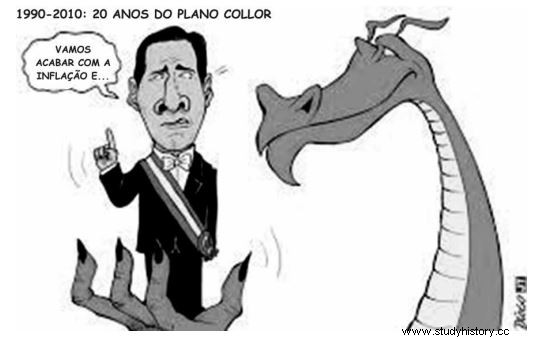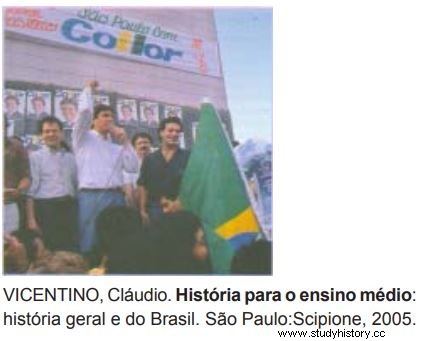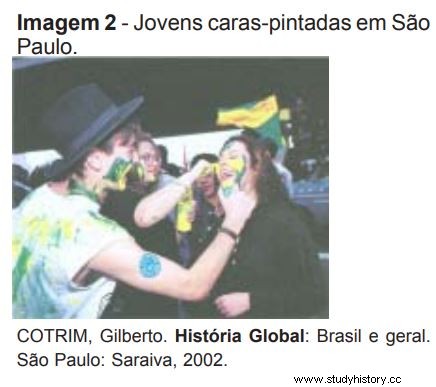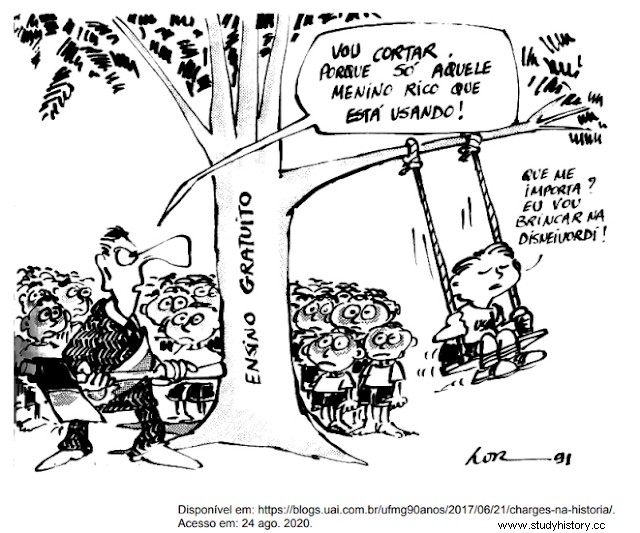Which candidate in the 1989 elections in Brazil attracted the support of different sectors of society, with a promise to modernize the economy, promoting neoliberal policies and opening up foreign participation in the national economy.
(A) Fernando Collor.
(B) Itamar Franco.
(C) Jose Sarney.
(D) João Figueiredo.
Question 02 - MPE- GO - 2018 - MPE-GO - Assistant Secretary - Águas Lindas -The first elected president of the so-called "New Republic", through direct elections in 1989, was Fernando Collor de Melo. About the Collor government, it is INCORRECT to say that:(A) it was interrupted by an impeachment process in 1992; (B) Itamar Franco was the vice-president of the Republic; (C) he started the Real Plan, which created the currency of the same name; (D) was marked, at the economic level, by the confiscation of Brazilian savings; (E) the popular movement that contributed to its end was called “Faces painted”.
Question 03 - Cásper Líbero 2017 - Corruption allegations, associated with the attrition of the then president, due to the implementation of economic stabilization plans, later led to popular mobilization and the approval of the impeachment request. The economic plans, called Collor I and Collor II, were basically aimed at controlling inflation. At first, the plans were effective, but the confiscation of money deposited in banks and the return of inflation stimulated people's discontent with the president.
Source:EBC http://www.ebc.com.br/ 2012/09/ha-20-years-fernando-collor-de-mello-was-the-first-president-of-brazil-to-suffer-process-from | Published:29/09/2012 | Access:09/28/2016 | Adapted The text alludes to the socioeconomic context that led then President Fernando Collor de Melo to impeachment. The context described in the text is marked by:a. political adherence to the government by the industrial productive sectors. B. administrative smoothness that made the impeachment process questionable. ç. bankruptcy of companies and recession, due to the confiscation of funds from bank accounts. d. acceptance of the President's letter of resignation, avoiding the loss of his political rights. and. popular movement in favor of the president's permanence, called “painted faces”.
Question 04 - Excellence Institute - 2016 - Municipality of Monte Azul Paulista - SP - The New Republic began in Brazil with the government of José Sarney in 1985, and remains until the present day. During his government, a new Constitution was drafted, enacted in 1988, which guaranteed direct and free elections to all elected positions. Given these historical facts in national politics, who was the first directly elected president since 1960, in 1989? a) Fernando Collor de Melo. b) Luiz Inácio Lula da Silva.c) Fernando Henrique Cardoso.d) None of the alternatives.
Question 05 - FUVEST 2002 - Transfer – The “Brasil Novo” plan announced by President Fernando Collor de Mello (1990), immediately after his inauguration in the Presidency of the Republic, introduced, among other measures, a) increase in taxes on all imports, renegotiation of the Brazilian external debt and reduction of oil imports; b) stimulus to private savings through subsidized interest, tax reform benefiting municipalities and universal access to secondary education; c) freezing of prices of goods and services, confiscation of current accounts and savings accounts, monetary reform converting cruzados new to cruises on a one-by-one basis; d) liberalization of imports of foreign products, confiscation of the reserves of large national banks, implementation of a free trade zone in each Brazilian state; e) reduction of pension amounts to eliminate the Social Security deficit, institution of high taxes on large estates unproductive, expansion of the private network of vocational education through a policy of tax incentives.
Question 06 - Mackenzie 2017/Morning -

During his election campaign, Fernando Collor de Mello promised to modernize the country and liquidate our inflation. However, as the cartoon above ironizes, its economic packages were not successful. Regarding the Collor Plan, a set of measures aimed at revitalizing our economy and which was announced the day after its inauguration, which took place on March 15, 1990, it is correct to say that a) it instituted the immediate freezing of prices of basic products, accompanied by gradual liberalization of wages, as well as resuming the monetary standard of the Cruzado.b) it established the price-fixing of the main foodstuffs for consumption, but allowed the free negotiation of wages, which benefited the working class.c) it started the program of state privatizations and advocated the need to carry out a violent cut in public spending, however, in practice, there was not a significant dismissal of employees. of 3 months, to avoid the remittance of national capital abroad. e) confiscated bank deposits in current accounts and savings accounts, in the amount r that exceeds the amount of 50 thousand cruzeiros, to avoid dislocation of resources for consumption.
Question 07 - IFBA 2017 - Integrated - Read the text below:“On the other hand, we had a president who was morally demoralized and repudiated by public opinion. Supported by politicians who insist on keeping alive the tradition of impunity, who remain blind to the demands of society, Collor, with his assistants, flaunted the argument that he is suffering a political lynching. In fact, it was the Brazilian people who suffered a political and moral lynching, deceived about the promises of public morality, social well-being and the modernization of the country. This government leaves as a legacy a post-war situation, with a miserable social reality and a state close to bankruptcy”. (José Genoíno. “New beginning for Brazil”. Folha de S. Paulo, 09/30/92).
From reading the text and understanding the neoliberal government of Fernando Collor de Mello (1990- 1992), indicate the statement(s) that best reflect the economic guidelines of that period. I - the Collor plan resorted to freezing prices and raising wages as a way out of the economic crisis and restored the Cruzado Novo to replace the Cruzeiro. II - The government confiscated bank deposits in current accounts, financial investments and savings accounts. III - The federal government increased public spending, supporting initiatives in the artistic and cultural sector and encouraging the development of scientific research. IV - His economic plan resulted in an almost immediate recession:bankruptcies, drop in sales, loss of purchasing power of wages and layoffs of workers, with thousands of unemployed. Mark the true alternative:A) only I. B) only II. C) only II and III. D) only II and IV. E) only I, III and IV.
Question 08 - PUCRS 2005.2 - The reform of the Brazilian state promoted by Fernando Collor de Mello (1990-92) is defined as neoliberal because it was based
A) on a policy of privatization and commercial opening to foreign competition.
B) on the increase in public investment and trade protectionism.
C) in issuing money and increasing taxes.
D) in a statist policy and in investment in basic industries.
E) in creation of new public companies and the liberalization of imports.
Question 09 - UFPR 2005 - Which alternative presents a factor that led to the ungovernability and subsequent impeachment of President Fernando Collor de Mello? a) Pressure from opposition parties, professional bodies and the student movement to investigate allegations of corruption in the government. b) Military conspiracy that culminated in a coup d'état, due to the leftist government policy and the diplomatic approach between the president and the communist countries. c) Involvement of the president in an attack on opposition leader Ulisses Guimarães. d) Reaction of the elites to the confiscation of savings by the Collor Plan and the taxation of financial capital. e) Pressure from the United States, which saw in the reforms proposed by Collor evidence of a protectionist policy harmful to their commercial interests.
Question 10 - FDF 2017 - The impeachment request of Fernando Collor de Mello, in 1992, was based on a complaint of
(A) crime of responsibility.
(B) drug trafficking.
(C) disrespect for the electoral legislation.
(D) embezzlement of parliamentary funds.
Question 11 - Excellence Institute - 2016 - Municipality of Monte Azul Paulista - SP - On December 29, 1992, then-President Fernando Collor de Mello resigned from his mandate, in the face of allegations of corruption and the impeachment process. About this historical fact, who definitively assumed the Presidency of the Republic?
a) Fernando Henrique Cardoso.
b) José Sarney.
c) Itamar Franco.
d) None of the alternatives.
Question 12 - UERJ 2002 - 1st Qualification Exam - “(...) We have, in the Collor government, the distance between two publicity:a publicity favorable to the government, aroused by it and even paid for, which was expressed in the incarnation of physical strength, better saying, of a positivity that did not refer to the no moral or political virtue, but reduced to the mere abuse of animality; and another publicity, which was fatal to him, when his brother went public to denounce the president as a public person, for corruption, and as a private person, for illegal or immoral acts, not all, however, of relevance to Brazilian society, such as those that referred to their sexual life.”(RIBEIRO, R. Janine. In:DAGNINO, Evelina (org.). The 90s:Politics and society in Brazil. São Paulo:Brasiliense, 1994.)
This text presents some reflections about the crisis that triggered the impeachment of President Fernando Collor de Mello. The political criticism that supports the author's concerns about that period can be translated as:
(A) The predominance of public image is harmful to democracy.
(B) Positive propaganda is fundamental in the consolidation of current governments.
(C) The emphasis on the private person stems from the fragility of public institutions.
(D) The public image is harmed with the dissemination of means of communication
Question 13 - UEMA - PAES 2 009 - Observing images 1 and 2, it can be concluded that
Image 1 - Speech by Fernando Collor de Mello.
 Image 2 - Young painted-faces in São Paulo.
Image 2 - Young painted-faces in São Paulo.
a) the first refers to the campaign that led Fernando Collor de Mello to victory in a election marked by the small number of candidates for the presidency of the Republic and the second refers to the ability of Fernando Collor de Mello to associate his image as the youngest candidate for the post of president with the students, considered the “future of the nation”.
b) the first refers to the speech that consecrated, regardless of the criticism made to his first government, the campaign towards the reelection of Fernando Collor de Mello as president of the Republic and the second refers to the mobilization triggered by the UNE, at the at the time of transition from the military dictatorship to redemocratization.
c) the first refers to President Fernando Collor de Mello's attempt to prevent the approval of the impeachment process by the Chamber of Deputies and the second illustrates the support that young students gave to the continuity of Fernando Collor de Mello in the position of president of the Republic when threatened by the military.
d) the first refers to Fernando Collor de Mello's campaign for the presidency of the Republic, who used the power of the press to exalt his image as the “hunter of maharajas”, and the second represents the mobilization of young students in defense of the impeachment of President Fernando Collor de Mello and a greater mobilization of national politics.
e) the first refers to the scenario expectations in Brazil regarding the possibility of the first direct elections for President of the Republic after the military dictatorship and the second refers to the widespread popular celebration of the election of Fernando Henrique Cardoso, considered, at the time, an opponent of Fernando Collor de Mello's policy. .
Question 14 - Mackenzie 2001 - The year 1992 was marked as the year of impeachment, an unprecedented event in the country and in the international context itself. Among the facts that contributed to this outcome are NOT included:
a) the successive allegations of corruption, aggravated by Pedro Collor's interview with Veja Magazine.
b) the failed defense of President Collor, presented by Cláudio Vieira, configured in the farcical Operation Uruguay.
c) the image of modernity and culture created by the media, which could not resist the mistakes of two years of Collor's government.
d) economic opening and Latin integration -American, facts that generated strong antagonism with the USA
e) the irregularities in the privatization process, the frauds in the bids and the embezzlement of funds.
Question 15 - UNIFOR 2004.1 - Analyze the text.
One of the most used words by Collor since the electoral campaign was "modern". He promised to modernize Brazil, and his own young figure, as well as that of some of his ministers, provided support for this type of discourse. By modernization, Collor understood the decrease in the role of the State, which included the defense of the free market, the opening to imports, the end of subsidies and privatizations. (Cláudio Vicentino and Gianpaolo Dorigo. História do Brasil.São Paulo:Scipione, 1998 , p.447)
For the president to which the text refers, “modernizing” Brazil meant
(A) nationalizing the most important economic sectors in the country.
(B) protecting the economy of the country through state protectionism.
(C) adapt the country to the new reality of global neoliberalism.
(D) implement an interventionist economic model in the country.
(E) reduce the country's poverty through of economic opening.
Question 16 - COLTEC 2022 - In this 1991 cartoon, the cartoonist LOR presents, on the one hand, President Collor's reformist commitment and, on the other, the reality of the vast majority of people affected by neoliberal reforms.
 The interpretation of the cartoon allows us to make a statement that is also a principle defended by neoliberals. Tick the alternative that makes a CORRECT interpretation of the cartoon. A) Acharge presents a criticism when defending welfare programs that favored the private sector. B) The cartoonist shows the purposes of neoliberal orientation of the Collor government to diminish the role of the State in the provision of free education. C) The cartoonist portrayed the population's clamor for reforms that had the objective of extinguishing social programs that privileged a minority. D) The government had a project to save public spending whose objective was to cut really unnecessary expenditures.
The interpretation of the cartoon allows us to make a statement that is also a principle defended by neoliberals. Tick the alternative that makes a CORRECT interpretation of the cartoon. A) Acharge presents a criticism when defending welfare programs that favored the private sector. B) The cartoonist shows the purposes of neoliberal orientation of the Collor government to diminish the role of the State in the provision of free education. C) The cartoonist portrayed the population's clamor for reforms that had the objective of extinguishing social programs that privileged a minority. D) The government had a project to save public spending whose objective was to cut really unnecessary expenditures.FEEDBACK
01 - A
02 - C
03 - C
04 - A
05 - C
06 - E
07 - D
08 - A
09 - A
10 - A
11 - C
12 - C
13 - D
14 - D
15 - C16 - B
